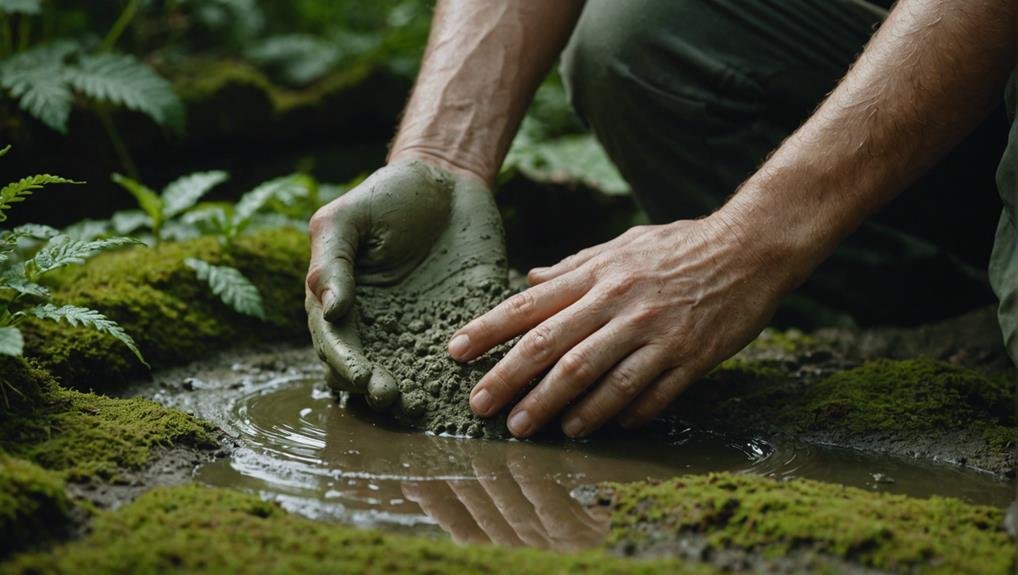To address leaks in small ponds, the first step is to inspect the area for any wet spots and conduct a dye test to identify the exact location of the leaks. Accurately measuring the pond's dimensions is crucial for determining the amount of materials needed.
Sodium Bentonite is a highly recommended option due to its excellent swelling properties that can effectively seal gaps and cracks. The application process typically involves clearing any debris and evenly spreading the Bentonite to create a seamless protective barrier.
Regularly monitoring the water levels is essential for promptly detecting any new leaks that may occur. By following these steps diligently, you can ensure thorough maintenance of your pond and prevent future leaks.
Explore further techniques to keep your pond leak-free for optimal enjoyment.
Identifying Pond Leaks
When identifying pond leaks, start by checking for wet areas around the pond. These wet spots can indicate where water is escaping.
Conduct a dye test by adding colored dye to the water to see where it flows out, helping to pinpoint the exact leak location.
If you notice a significant water loss or the water level dropping faster than usual, it's a sign of a leak. Inspect the pond liner for tears, holes, or damages that may be causing the leaks. Sometimes, these issues aren't visible from the surface, so a thorough inspection is crucial.
If the leak source is still not found, consider draining the pond for a closer look at the entire structure.
Once the leak is identified, proceed with the necessary repairs to prevent further water loss. Timely detection and resolution of these issues are vital for maintaining the health and functionality of small ponds.
Measuring Pond Size
Accurately measuring the size of your pond is crucial for effective maintenance and repair planning. To start, it's important to measure the length and width of the pond. For smaller ponds with rectangular or square shapes, you can simply multiply these dimensions to find the area. However, if your pond has irregular shapes, a different approach is needed.
Breaking down the pond into smaller, more manageable sections allows for a precise calculation of the total area.
After determining the area, measuring the perimeter of the pond is the next step. You can use a measuring tape or a wheel to follow the edge of the pond and obtain this measurement. Knowing the exact size of your pond, including both the area and perimeter, is essential for accurately estimating the materials needed for repairs or maintenance tasks.
By ensuring that your pond is accurately measured, you're taking proactive steps to maintain its health and longevity. This approach also helps prevent unnecessary expenses on excess materials, enables precise planning for leak repairs or other maintenance, maximizes the efficiency of your efforts, and boosts your confidence in managing your pond effectively.
Selecting Bentonite Type

Selecting the right type of bentonite for sealing your pond is crucial for effectively addressing leaks and ensuring long-term durability. When it comes to pond sealing, you have two main types of bentonite to consider: Sodium Bentonite and Calcium Bentonite. Understanding the differences between these two options is key to making an informed decision.
Sodium Bentonite is a popular choice due to its high swelling capacity. It can absorb water up to 15 times its volume, making it highly effective for sealing small pond leaks. Its impressive ability to swell allows it to fill gaps and cracks efficiently, creating a reliable seal that helps prevent water loss.
On the other hand, Calcium Bentonite, although also suitable for pond sealing, has a lower swelling capacity compared to Sodium Bentonite. While it may not absorb as much water, it still provides good sealing properties for addressing minor leaks in ponds. If Sodium Bentonite isn't readily available, or specific conditions call for it, Calcium Bentonite can be a viable alternative.
When deciding on the type of bentonite to use, consider the specific conditions of your pond and the severity of leaks. In most cases, Sodium Bentonite with its higher swelling capacity is the preferred choice for sealing small pond leaks effectively. However, having an understanding of the distinctions between these options ensures that you select the most suitable bentonite for your particular needs.
Preparing Bentonite Quantity
Calculating the correct amount of bentonite is crucial for effectively sealing leaks in your pond. To begin, we must measure the size of the pond to estimate the required bentonite quantity accurately. Understanding the soil composition is also vital, as different soil types interact differently with bentonite, impacting its sealing effectiveness. This knowledge is key to our quantity calculation.
If possible, pinpointing the exact location of the leak allows for a more targeted application of bentonite. This focused approach ensures that the bentonite is applied where it's needed most. Once we've gathered all the necessary information, we can determine the precise amount of bentonite needed. This precise calculation ensures that we use enough bentonite for a successful seal without wastage.
Preparation before applying bentonite is essential. It involves ensuring that the pond surface is adequately prepared to receive the bentonite, maximizing its sealing potential.
Blanket Method Application

After determining the correct amount of bentonite needed, we can proceed with the application using the Blanket Method, a simple and effective approach for addressing leaks in small ponds.
To start, it's essential to clear any debris from the pond surface to ensure proper adhesion of the bentonite mix. A clean and smooth pond surface is key to achieving optimal results.
Once the surface is prepared, the bentonite mix should be evenly distributed across the affected area of the pond. This uniform application is crucial in creating a consistent protective layer that can efficiently seal any leaks, ultimately reducing water seepage and maintaining the water level in the pond.
The Blanket Method entails forming a continuous bentonite layer over the pond's surface, serving as a barrier to prevent water from leaking out. This method has been proven effective for small ponds, offering a natural and cost-efficient solution to address water loss issues.
Mixed Blanket Technique
The Mixed Blanket Technique is a highly effective method for preventing water seepage in ponds by incorporating bentonite into the soil through tilling. By applying a bentonite mix to the pond surface and thoroughly tilling it, we can create a strong barrier that significantly enhances the seal's integrity. This technique is especially useful for fixing leaks in small ponds, ensuring consistent water levels.
To begin, it's crucial to properly prepare the pond surface by removing any debris and ensuring the soil is ready for the bentonite mix. Through careful application and tilling, the bentonite becomes integrated into the soil, forming a protective barrier against water seepage. Attention to detail during mixing and tilling is key to ensuring even distribution and full absorption of the bentonite into the soil.
Utilizing the Mixed Blanket Technique brings a sense of accomplishment and peace of mind. Some advantages include effective leak sealing, long-term maintenance of water levels, affordability, environmental friendliness, and improved overall pond health.
Sprinkle Method Steps

When using the Sprinkle Method to seal leaks in your pond, the first step is to evenly spread bentonite over the pond's surface. This is crucial to ensure that the bentonite covers all areas where water is present, maximizing its sealing effectiveness.
Once the bentonite is spread out, it will start to hydrate by absorbing water and swelling into a gel-like substance. This hydrated bentonite will then settle into the soil at the bottom of the pond, filling in any cracks or gaps that may be causing leaks.
The hydration process of the bentonite typically takes a few days, so it's important to be patient and allow it enough time to expand and create a solid seal. By applying the Sprinkle Method, you're taking a simple yet effective approach to reduce water seepage in your pond.
By ensuring even distribution of bentonite, you increase the chances of successfully sealing any leaks. Within about a week, you should start to see a noticeable decrease in pond leaks as the bentonite continues to settle and form a reliable barrier against seepage.
This method offers a practical solution for maintaining a leak-free and healthy pond.
Monitoring Results
Monitoring the results of our pond leak repairs is essential to assess the effectiveness of the chosen method. It's important to regularly check water levels and watch for any signs of leaks to ensure that the repairs are holding up well. By keeping track of changes in water loss rates, we can gain valuable insights into the overall condition of the pond and the success of the repair work.
To effectively monitor the results, we should:
- Check water levels on a daily basis to promptly identify any sudden drops that could indicate a new or recurring leak.
- Be on the lookout for signs of leaks, such as wet spots around the pond or unusual water patterns, which may indicate underlying issues.
- Keep detailed records of water loss rates before and after the repairs to evaluate the effectiveness of our efforts.
- Conduct regular inspections to maintain the pond's integrity and address any potential problems early on.
- Analyze the data on water loss to make well-informed decisions regarding future repairs and maintenance tasks.
Conclusion
We've covered the steps to find and fix leaks in small ponds, ensuring they stay full and healthy. Bentonite plays a crucial role in sealing those pesky leaks, acting as a silent hero.
By following these methods, we're not just maintaining a pond; we're safeguarding a vital ecosystem. Let's stay alert and keep our ponds flourishing.

